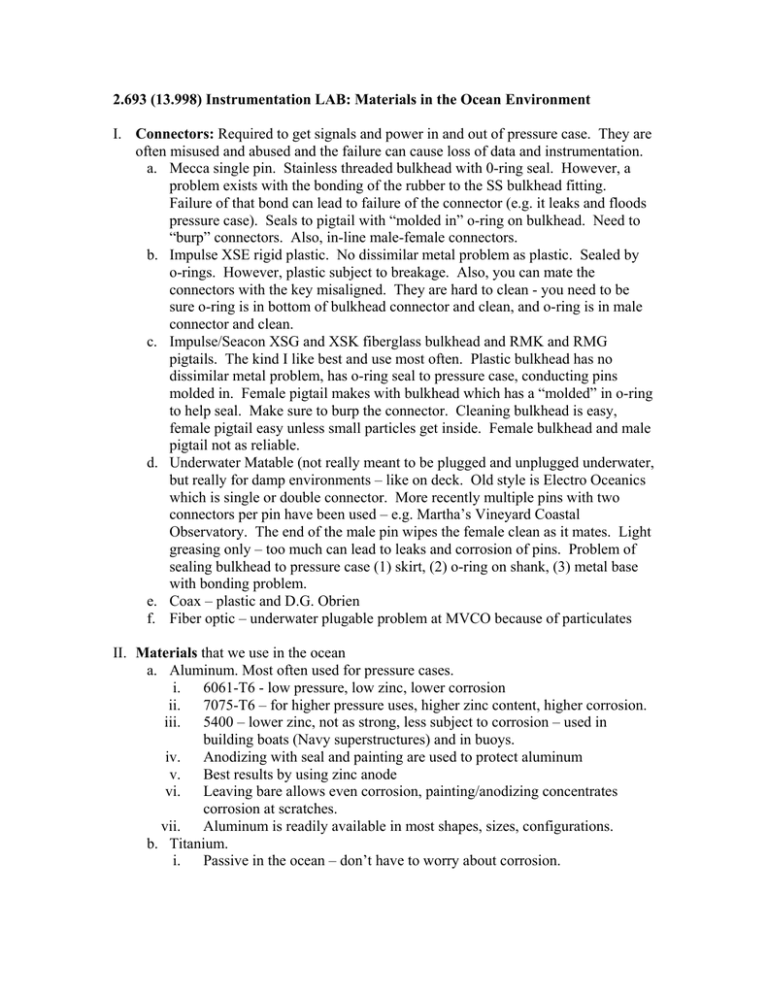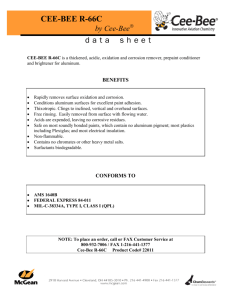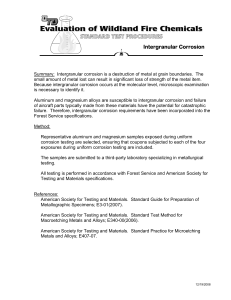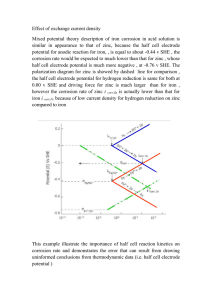2.693 (13.998) Instrumentation LAB: Materials in the Ocean Environment Connectors:
advertisement

2.693 (13.998) Instrumentation LAB: Materials in the Ocean Environment I. Connectors: Required to get signals and power in and out of pressure case. They are often misused and abused and the failure can cause loss of data and instrumentation. a. Mecca single pin. Stainless threaded bulkhead with 0-ring seal. However, a problem exists with the bonding of the rubber to the SS bulkhead fitting. Failure of that bond can lead to failure of the connector (e.g. it leaks and floods pressure case). Seals to pigtail with “molded in” o-ring on bulkhead. Need to “burp” connectors. Also, in-line male-female connectors. b. Impulse XSE rigid plastic. No dissimilar metal problem as plastic. Sealed by o-rings. However, plastic subject to breakage. Also, you can mate the connectors with the key misaligned. They are hard to clean - you need to be sure o-ring is in bottom of bulkhead connector and clean, and o-ring is in male connector and clean. c. Impulse/Seacon XSG and XSK fiberglass bulkhead and RMK and RMG pigtails. The kind I like best and use most often. Plastic bulkhead has no dissimilar metal problem, has o-ring seal to pressure case, conducting pins molded in. Female pigtail makes with bulkhead which has a “molded” in o-ring to help seal. Make sure to burp the connector. Cleaning bulkhead is easy, female pigtail easy unless small particles get inside. Female bulkhead and male pigtail not as reliable. d. Underwater Matable (not really meant to be plugged and unplugged underwater, but really for damp environments – like on deck. Old style is Electro Oceanics which is single or double connector. More recently multiple pins with two connectors per pin have been used – e.g. Martha’s Vineyard Coastal Observatory. The end of the male pin wipes the female clean as it mates. Light greasing only – too much can lead to leaks and corrosion of pins. Problem of sealing bulkhead to pressure case (1) skirt, (2) o-ring on shank, (3) metal base with bonding problem. e. Coax – plastic and D.G. Obrien f. Fiber optic – underwater plugable problem at MVCO because of particulates II. Materials that we use in the ocean a. Aluminum. Most often used for pressure cases. i. 6061-T6 - low pressure, low zinc, lower corrosion ii. 7075-T6 – for higher pressure uses, higher zinc content, higher corrosion. iii. 5400 – lower zinc, not as strong, less subject to corrosion – used in building boats (Navy superstructures) and in buoys. iv. Anodizing with seal and painting are used to protect aluminum v. Best results by using zinc anode vi. Leaving bare allows even corrosion, painting/anodizing concentrates corrosion at scratches. vii. Aluminum is readily available in most shapes, sizes, configurations. b. Titanium. i. Passive in the ocean – don’t have to worry about corrosion. ii. Same strength to weight ratio as aluminum – pressure case with same depth rating is half the thickness but the same weight as aluminum. iii. Harder to get material configured – e.g. no tubes and must get block and machine. Save borings to recycle. iv. Harder to machine if you aren’t experienced and have the right tools. v. More expensive. vi. Available in nuts, bolts, washers, etc. vii. Note that the Sea-Bird Microcat with which you did the CTD profile is made with a Titanium case. c. Stainless Steel – Again used often as fasteners. i. Alloy most used is 316 (must have this stamped on the part or it is probably not 316. This is one of the better stainless steels for use in the ocean. ii. Another type often used is 17-4ph. This is used for load cells (because of the mechanical properties under stress), and for pressure cases (Neal Brown CTD and Benthos acoustic release). The anode for 17-4ph is soft iron. iii. In anoxic environments stainless steel is subject to crevice corrosion. d. Steel: i. Used in ships (KNORR, OCEANUS, ATLANTIS) – TIOGA is aluminum. ii. Anchors, galvanized chain, shackles, etc iii. Coast Guard navigation buoys iv. Older scientific buoys – require regular maintenance, sanding painting,etc. e. Glass is as inert a material as you can get i. Used by Benthos (and others) as flotation spheres. 10” and 17” diameter. ii. 17” diameter in plastic “hard hat” gives about 50 lbs buoyancy. iii. Will go to deepest ocean depths. iv. Sealed by warming air on inside, and mating two halves together (with no grease or sealant on the glass to glass surfaces. If there is something then the glass will tend to spawl, and weaken. Need bare glass to keep the properties of a complete glass sphere. Joint is sealed by tape on the outside to prevent slow air leaks. v. Note that at 2/3 atmosphere pressure inside (or 5 psi difference from atmosphere), a 17” glass ball has about 1,000 lbs holding it together. vi. Another pressure case is made from the glass plumbing you see in scientific laboratories and buildings. You can get a 6’ foot section with round end. Then you seal it on the other end with a flat end cap. This is the pressure case for a RAFOS float (a Lagrangian drifter that tracks ocean currents). f. Syntatic foam i. This is a glass epoxy mix. It is the additional flotation for ALVIN and used in deep ocean flotation spheres (see the bright orange 6 foot diameter spheres on the WHOI dock). ii. It is made from small glass spheres. These are pressurized to the depth rating of the foam, and the spheres that do not crush (but float) are then mixed with epoxy to hold them together in the desired shape. It can be machined (hard on tools). iii. Heavy for amount of flotation, and expensive, but has its place in the ocean g. Surlyn foam i. A “nearly” closed cell foam that doesn’t absorb water. ii. However as the cells are at atmospheric pressure, the foam collapses when pulled under water – example GLOBE guard buoy. iii. Used by the Coast Guard for navigational buoys and small marker buoys iv. Also used as fender material for boats v. Used by WHOI for buoy flotation – GLOBEC, GoMOOS, Buoy Farm and MVCO buoys on dock, etc. vi. Rolled up into whatever size you want (maximum thickness of one roll is 6 feet). vii. Outside melted and rolled into a hard cover. viii. Ships like to work with buoys with foam flotation as they can hold them tight to the ship without damaging buoy or ship. h. PVC –grey plastic often used in the ocean i. shallow water pressure cases ii. sensor mounting blocks iii. soft, easy to machine, iv. often broken by shock, especially in cold weather v. does absorb some moisture with time vi. Have made shallow water pressure cases with plumbing fittings and pipe. i. Delron – black or white plastic i. shallow water pressure cases ii. sensor mounting blocks iii. harder than PVC iv. often broken by shock, especially in cold weather j. Ropes – drastically changed from old manila ropes used on sailing vessels. See Walter Paul on top floor of Bigelow if you are really interested in the details of ropes and rope failures. i. Nylon – stretchy, strong, if stored wet shrinks in lengths. Used in deep ocean moorings for compliance. ii. Polypropylene – floats and is often used by water skiers as tow ropes. Degrades in sunlight. iii. Spectra, Vectran, Kevlar – newer fiber ropes, less stretch, stronger (than steel cables nearly the same diameter), much easier to work with than steel, longer life in ocean, etc. III. Instrument Cases and closures a. Spheres – aluminum (Munk Snodgrass tide guage), in glass balls (cameras, Benthos acoustic beacons, AUVs, etc.). Can put a penetrator in the glass for electrical connector. b. Cylindrical – the most common pressure case. Made of aluminum, titanium, steel, plastics (PVC especially). These need an end cap to seal the vessel. c. Flat plate end caps. Use a plate rather than a section of a rod as the “grain” of the metal shouldn’t be parallel to the pressure case (corrosion generally runs with the grain of the metal). d. Spherical end caps – these can be glass or metal, cast or machined. The end cap has to be machined to mate closely with the cylinder. The seal could be face or piston type of o-rings (see below). e. Closures – these hold the end cap to the pressure case until the assembly gets into the water, then the water pressure will hold it closed. i. V-band clamps ii. Tie-rods outside the pressure case iii. Screws through the end cap into the cylinder iv. Interrupted thread – the gun breach, often used on AUVs. v. Rod in groove – MAVS current meter. IV. O-Rings a. Types b. In Oceanographic Applications, mostly static. c. Configurations i. Face seal – in end cap against cylinder ii. Piston seal – in part of end cap that extends into cylinder. Dimensions are critical to proper seal. See handout sheet. d. Clean, inspect, grease install – do it with several pressure cases. V. Corrosion –a major problem in the ocean since it has so much dissolved material, it is conductive and can help drive galvanic corrosion a. Electromotive chart and anode protection b. Aluminum i. 6061 works OK if left bare ii. 7075 self corrodes because of inhomogenities in the material iii. Hardcoat anodize and seal iv. Zinc anode protects (be sure you have anode quality zinc) v. Copper ions are poison c. Stainless steel i. Crevice corrosion and pit corrosion ii. Mild steel as an anode iii. Oxygen depletion – anoxic conditions with little flow, underneath clamps, tape, etc. iv. Hydrogen embrittlement v. Electropolishing and passivating stainless steel d. Titanium i. Immune from corrosion ii. Acts as a cathode to other metals e. Monel, Bronze, BeCu, i. Antifouling – because copper is poison to life ii. Low corrosion iii. Acts as a cathode to other metals iv. Poisons aluminum f. Brass i. Dezincifies g. Galvanized iron, steel i. Galvanizing (zinc) acts as a sacrificial surface coaling ii. Depending on conditions, 2 to 5 year life. iii. Oil platforms moored with chain use zinc anodes to protect chain. iv. Chain in moorings corrodes on outside, and when on the bottom, the corrosion products are removed by rubbing on the bottom to leave bare metal for more corrosion.






